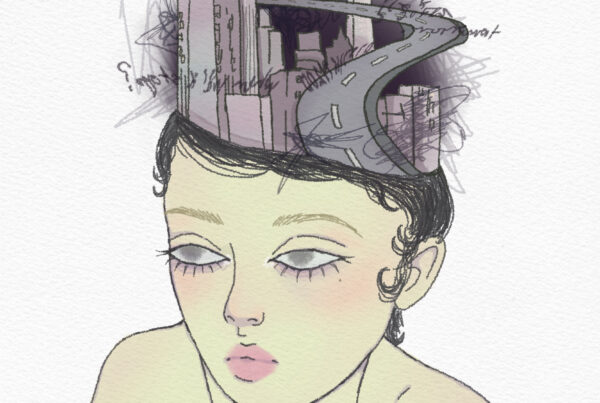
Girlhood is a constraining force. Albeit one which provides oppressed people a sense of community built on love, compassion, and understanding. Gender’s existence is undeniable, not in a bio-essentialist understanding of the construct but as a product of material conditions which brought it to existence. It consists of cultural factors as well as psychological factors, most notably one’s sense of gender identity which also operates as a political structure at a societal level. Thus gender can be conceptualized as the conformity to implicit social norms, as one’s gender identity needs to be contextualized with the political forces that influence it.
Girlhood is a constraining force. Albeit one which provides oppressed people a sense of community built on love, compassion, and understanding. Gender’s existence is undeniable, not in a bio-essentialist understanding of the construct but as a product of material conditions which brought it to existence. It consists of cultural factors as well as psychological factors, most notably one’s sense of gender identity which also operates as a political structure at a societal level. Thus gender can be conceptualized as the conformity to implicit social norms, as one’s gender identity needs to be contextualized with the political forces that influence it.

Photo by Pika Ivana Kostanjšek

Photo by Pika Ivana Kostanjšek
To presume sex – which can be better understood as a bimodal distribution curve instead of a binary category (David Ludden, 2016) – as an incontestable innate ‘truth’ is to deny the violence of the enforcement of the gender on the body. The biological approach to Psychology emphasizes the importance of sex in gender differences but a systematic analysis on personality has shown that those differences change in response to cultural shifts in what is perceived to be appropriate for each gender (Twenge, 2001). This suggests that gender differences are, at least partly, a cultural product which nonetheless bases itself on bio essentialism – where biological underpinnings are given more importance than environmental factors – so its existence can go largely unquestioned. Fundamentally, gender is a biopolitical structure which shapes our identities to be aligned with the hegemonic patriarchal forces. Namely as a way to establish power through the hypervigilance of the self in societal relations in an attempt to conform to culturally relative gender schemas as to increase social desirability through normative social influence (Rudman et al., 2010). The ‘ideal self’ becomes political territory and the incongruence with the ‘real self’ grows larger, impeding people from reaching self actualization, which is the highest level of Maslow’s hierarchy of needs. Whilst gender identity is related to self expression, its categories are still restrictive, as descriptors meant to encompass half of the world’s population can’t account for individuality. To illustrate this, research has shown that when asked to define girlhood, female participants mostly talked about its constraints (Imani Minor, 2021). Therefore, through biological essentialism, girlhood is turned into a constricting structure.
Psychology has long tried to find a reason for women’s suffering whilst working within a gender binary framework, which limited their theories to biological essentialism. Notoriously, the psychoanalytical approach to gender development can be seen as a theoretical justification of women’s subjugation through the importance given to the penis in psychological development. A woman is supposedly born as lesser and is doomed to endure self-hate due to her biological inferiority. The penis envy turns into desire to be a mother and the oedipal stage is never fully resolved. While this theory is outdated and ludicrous, the torment of girlhood is still a subject worth exploring. Its pain is not biologically inbuilt but still so overarching it is easy to mistake it as inherent. And – for lack of better descriptors – girlhood seems like just a categorization of a certain type of suffering. This is supported by research which shows that women tend to score higher on neuroticism, which suggests their tendency to experience negative emotions is so significant that it often becomes a facet of their personality (Grijalva et al., 2015). The reason for such suffering is cultural, more specifically a product of the patriarchy. As a minority, women are more prone to experiencing discrimination as well as sexual and intimate partner violence. This contributes to the development of psychological disorders, such as depression and anxiety, which occur disproportionately more in women (Nolen-Hoeksema, 2001). Other risk factors for the aforementioned psychological disorders are the enforcement of reproductive labour (Almeida & Kessler, 1998; Barnett & Baruch, 1987) – which includes the unequal division of household chores and childcare – as well as women’s tendency to ruminate on their distress and make internal attributions for their causes (Nolen-Hoeksema, 2001). The concept of the feminine cannot exist without its subjugation, it implies suffering by the very nature of the gender system of which it’s a part of. Girlhood is fundamentally restrictive and oppressing, and yet girls are able to find comfort in it.
“To find comfort in what oppresses you is not a way to stay complacent but simply a means of survival.”
Girlhood flourishes despite the violence it endures, and it centers itself around the same concept which restricts its full expression. Feminine gender roles revolve mostly around the private sphere, as there is a great emphasis on the reproductive labour of domesticity and motherhood (Gillis S., Hollows J., 2008). While this prevents women from pursuing certain career paths, it could also explain why women are on average more concerned with developing positive social connections than men (Kashima et al., 1995). Girlhood becomes a sense of community built on shared understanding of oppression, which nonetheless doesn’t limit itself to its suffering. Moreover the social forces that encourage girls to conform to feminine gender roles could be the cause of gender differences in personality, such as women scoring higher on the dimensions of agreeableness, as well as the facets of warmth and sociability of extraversion (McCrae & Terracciano, 2005). Consequently, conformity to feminine gender roles has been linked with care for others (Mahalik J.R., Morray E.B., 2005). This is coherent with the evolutionary explanation for gender differences, which suggests that its universality is derived from long existing social roles where women were more encouraged to foster nurturing and cooperative qualities (Larsen & Buss, 2008).Therefore, despite the confining nature of girlhood, some of the qualities fostered by the conformity to feminine gender roles can be positive. It’s only natural that a strong sense of companionship would arise from such qualities, especially in the face of oppression, where social support is needed to thrive as an individual. In fact, research has shown that female mammals tend to respond to stressful situations by trying to strengthen social connections, which is possibly due to their higher level of oxytocin (Shelley Taylor et al., 2000). The researchers additionally suggested that females’ response to distress is marked by a “tend-and-befriend” mechanism as opposed to the usual fight or flight response. This is a potential explanation for why women are more likely to seek support from friends when faced with unfortunate circumstances. Therefore, the sense of community girls find in each other’s presence can be their solace in the face of subjugation and dehumanization.
Nietzsche’s affirmation of suffering states how people should be able to affirm their existence despite the suffering they endure and ultimately this is what girlhood is about; a sense of community built on shared oppression and also despite of it, a concept separate from the gendering of the body but that only exists because of it. From dialectical behavioural therapy’s radical acceptance to Camus’ acceptance of the absurd it seems that it’s girls who know best how to build a positive community out of unfortunate circumstances. To find comfort in what oppresses you is not a way to stay complacent but simply a means of survival. <<
References
-
Almeida, D. M., & Kessler, R. C. (1998). Everyday stressors and gender differences in daily distress. Journal of Personality and Social Psychology, 75(3), 670–680. https://doi.org/10.1037/0022-3514.75.3.670
-
Baruch, G. K., Biener, L., & Barnett, R. C. (1987). Women and gender in research on work and family stress. American Psychologist, 42(2), 130–136. https://doi.org/10.1037/0003-066X.42.2.130
-
Costa, Paul & Terracciano, A. & McCrae, R.R.. (2001). Gender differences in personality traits across cultures: Robust and surprising findings. Journal of Personality and Social Psychology. 81. 322-331. 10.1037/0022-3514.81.2.322.
-
Gillis, S., & Hollows, J. (Eds.). (2008). Feminism, Domesticity and Popular Culture (1st ed.). Routledge. https://doi.org/10.4324/9780203889633
-
Grijalva, Emily & Newman, Daniel & Tay, Louis & Donnellan, M & Harms, Peter & Robins, Richard & Yan, Taiyi. (2014). Gender Differences in Narcissism: A Meta-Analytic Review. Psychological Bulletin. 10.1037/a0038231.
-
Kashima, Yoshihisa & Yamaguchi, Susumu & Kim, Uichol & Choi, Sang-Chin & Gelfand, Michele & Yuki, Masaki. (1995). Culture, Gender, and Self: A Perspective From Individualism-Collectivism Research. Journal of Personality and Social Psychology. 69. 925-937. 10.1037/0022-3514.69.5.925.
-
Larsen, Randy & Buss, David. (2005). Personality Psychology: Domains of Knowledge about Human Nature.
-
Ludden D. (2016, November 21) When Sex and Gender Don’t Match Psychology Today https://www.psychologytoday.com/us/blog/talking-apes/201611/when-sex-and-gender-don-t-match#:~:text=Rather%2C%20people’s%20sex%20is%20spread,others%20have%20somewhat%20female%20characteristics.b
-
Mahalik, J.R., Morray, E.B., Coonerty-Femiano, A., Ludlow, L.H., Slattery, S.M. and Smiler, A. (2005) Development of the Conformity to Feminine Norms Inventory. Sex Roles, 52, 417-435. http://dx.doi.org/10.1007/s11199-005-3709-7
-
Mambrol N. (2018, November 20) Psychoanalysis and Gender Literary Theory and Criticism https://literariness.org/2018/11/20/psychoanalysis-and-gender/
-
Minor I. (2021, July 28) Navigating Girlhood in a Society That Restricts Their Humanity. Psychology Today. https://www.psychologytoday.com/us/blog/who-am-i-who-are-we/202107/navigating-girlhood-in-society-restricts-their-humanity
-
Nolen-Hoeksema, S. (2001). Gender differences in depression. Current Directions in Psychological Science, 10(5), 173–176. https://doi.org/10.1111/1467-8721.00142
-
Rudman, Laurie & Phelan, Julie. (2010). The Effect of Priming Gender Roles on Women’s Implicit Gender Beliefs and Career Aspirations. Social Psychology – SOC PSYCHOL. 41. 192-202. 10.1027/1864-9335/a000027.
-
Taylor, S. E., Klein, L. C., Lewis, B. P., Gruenewald, T. L., Gurung, R. A. R., & Updegraff, J. A. (2000). Biobehavioral responses to stress in females: Tend-and-befriend, not fight-or-flight. Psychological Review, 107(3), 411–429. https://doi.org/10.1037/0033-295X.107.3.411
-
Twenge, J. M. (2001). Changes in women’s assertiveness in response to status and roles: A cross-temporal meta-analysis, 1931–1993. Journal of Personality and Social Psychology, 81(1), 133–145. https://doi.org/10.1037/0022-3514.81.1.133
To presume sex – which can be better understood as a bimodal distribution curve instead of a binary category (David Ludden, 2016) – as an incontestable innate ‘truth’ is to deny the violence of the enforcement of the gender on the body. The biological approach to Psychology emphasizes the importance of sex in gender differences but a systematic analysis on personality has shown that those differences change in response to cultural shifts in what is perceived to be appropriate for each gender (Twenge, 2001). This suggests that gender differences are, at least partly, a cultural product which nonetheless bases itself on bio essentialism – where biological underpinnings are given more importance than environmental factors – so its existence can go largely unquestioned. Fundamentally, gender is a biopolitical structure which shapes our identities to be aligned with the hegemonic patriarchal forces. Namely as a way to establish power through the hypervigilance of the self in societal relations in an attempt to conform to culturally relative gender schemas as to increase social desirability through normative social influence (Rudman et al., 2010). The ‘ideal self’ becomes political territory and the incongruence with the ‘real self’ grows larger, impeding people from reaching self actualization, which is the highest level of Maslow’s hierarchy of needs. Whilst gender identity is related to self expression, its categories are still restrictive, as descriptors meant to encompass half of the world’s population can’t account for individuality. To illustrate this, research has shown that when asked to define girlhood, female participants mostly talked about its constraints (Imani Minor, 2021). Therefore, through biological essentialism, girlhood is turned into a constricting structure.
Psychology has long tried to find a reason for women’s suffering whilst working within a gender binary framework, which limited their theories to biological essentialism. Notoriously, the psychoanalytical approach to gender development can be seen as a theoretical justification of women’s subjugation through the importance given to the penis in psychological development. A woman is supposedly born as lesser and is doomed to endure self-hate due to her biological inferiority. The penis envy turns into desire to be a mother and the oedipal stage is never fully resolved. While this theory is outdated and ludicrous, the torment of girlhood is still a subject worth exploring. Its pain is not biologically inbuilt but still so overarching it is easy to mistake it as inherent. And – for lack of better descriptors – girlhood seems like just a categorization of a certain type of suffering. This is supported by research which shows that women tend to score higher on neuroticism, which suggests their tendency to experience negative emotions is so significant that it often becomes a facet of their personality (Grijalva et al., 2015). The reason for such suffering is cultural, more specifically a product of the patriarchy. As a minority, women are more prone to experiencing discrimination as well as sexual and intimate partner violence. This contributes to the development of psychological disorders, such as depression and anxiety, which occur disproportionately more in women (Nolen-Hoeksema, 2001). Other risk factors for the aforementioned psychological disorders are the enforcement of reproductive labour (Almeida & Kessler, 1998; Barnett & Baruch, 1987) – which includes the unequal division of household chores and childcare – as well as women’s tendency to ruminate on their distress and make internal attributions for their causes (Nolen-Hoeksema, 2001). The concept of the feminine cannot exist without its subjugation, it implies suffering by the very nature of the gender system of which it’s a part of. Girlhood is fundamentally restrictive and oppressing, and yet girls are able to find comfort in it.
“To find comfort in what oppresses you is not a way to stay complacent but simply a means of survival.”
Girlhood flourishes despite the violence it endures, and it centers itself around the same concept which restricts its full expression. Feminine gender roles revolve mostly around the private sphere, as there is a great emphasis on the reproductive labour of domesticity and motherhood (Gillis S., Hollows J., 2008). While this prevents women from pursuing certain career paths, it could also explain why women are on average more concerned with developing positive social connections than men (Kashima et al., 1995). Girlhood becomes a sense of community built on shared understanding of oppression, which nonetheless doesn’t limit itself to its suffering. Moreover the social forces that encourage girls to conform to feminine gender roles could be the cause of gender differences in personality, such as women scoring higher on the dimensions of agreeableness, as well as the facets of warmth and sociability of extraversion (McCrae & Terracciano, 2005). Consequently, conformity to feminine gender roles has been linked with care for others (Mahalik J.R., Morray E.B., 2005). This is coherent with the evolutionary explanation for gender differences, which suggests that its universality is derived from long existing social roles where women were more encouraged to foster nurturing and cooperative qualities (Larsen & Buss, 2008).Therefore, despite the confining nature of girlhood, some of the qualities fostered by the conformity to feminine gender roles can be positive. It’s only natural that a strong sense of companionship would arise from such qualities, especially in the face of oppression, where social support is needed to thrive as an individual. In fact, research has shown that female mammals tend to respond to stressful situations by trying to strengthen social connections, which is possibly due to their higher level of oxytocin (Shelley Taylor et al., 2000). The researchers additionally suggested that females’ response to distress is marked by a “tend-and-befriend” mechanism as opposed to the usual fight or flight response. This is a potential explanation for why women are more likely to seek support from friends when faced with unfortunate circumstances. Therefore, the sense of community girls find in each other’s presence can be their solace in the face of subjugation and dehumanization.
Nietzsche’s affirmation of suffering states how people should be able to affirm their existence despite the suffering they endure and ultimately this is what girlhood is about; a sense of community built on shared oppression and also despite of it, a concept separate from the gendering of the body but that only exists because of it. From dialectical behavioural therapy’s radical acceptance to Camus’ acceptance of the absurd it seems that it’s girls who know best how to build a positive community out of unfortunate circumstances. To find comfort in what oppresses you is not a way to stay complacent but simply a means of survival. <<
References
-
Almeida, D. M., & Kessler, R. C. (1998). Everyday stressors and gender differences in daily distress. Journal of Personality and Social Psychology, 75(3), 670–680. https://doi.org/10.1037/0022-3514.75.3.670
-
Baruch, G. K., Biener, L., & Barnett, R. C. (1987). Women and gender in research on work and family stress. American Psychologist, 42(2), 130–136. https://doi.org/10.1037/0003-066X.42.2.130
-
Costa, Paul & Terracciano, A. & McCrae, R.R.. (2001). Gender differences in personality traits across cultures: Robust and surprising findings. Journal of Personality and Social Psychology. 81. 322-331. 10.1037/0022-3514.81.2.322.
-
Gillis, S., & Hollows, J. (Eds.). (2008). Feminism, Domesticity and Popular Culture (1st ed.). Routledge. https://doi.org/10.4324/9780203889633
-
Grijalva, Emily & Newman, Daniel & Tay, Louis & Donnellan, M & Harms, Peter & Robins, Richard & Yan, Taiyi. (2014). Gender Differences in Narcissism: A Meta-Analytic Review. Psychological Bulletin. 10.1037/a0038231.
-
Kashima, Yoshihisa & Yamaguchi, Susumu & Kim, Uichol & Choi, Sang-Chin & Gelfand, Michele & Yuki, Masaki. (1995). Culture, Gender, and Self: A Perspective From Individualism-Collectivism Research. Journal of Personality and Social Psychology. 69. 925-937. 10.1037/0022-3514.69.5.925.
-
Larsen, Randy & Buss, David. (2005). Personality Psychology: Domains of Knowledge about Human Nature.
-
Ludden D. (2016, November 21) When Sex and Gender Don’t Match Psychology Today https://www.psychologytoday.com/us/blog/talking-apes/201611/when-sex-and-gender-don-t-match#:~:text=Rather%2C%20people’s%20sex%20is%20spread,others%20have%20somewhat%20female%20characteristics.b
-
Mahalik, J.R., Morray, E.B., Coonerty-Femiano, A., Ludlow, L.H., Slattery, S.M. and Smiler, A. (2005) Development of the Conformity to Feminine Norms Inventory. Sex Roles, 52, 417-435. http://dx.doi.org/10.1007/s11199-005-3709-7
-
Mambrol N. (2018, November 20) Psychoanalysis and Gender Literary Theory and Criticism https://literariness.org/2018/11/20/psychoanalysis-and-gender/
-
Minor I. (2021, July 28) Navigating Girlhood in a Society That Restricts Their Humanity. Psychology Today. https://www.psychologytoday.com/us/blog/who-am-i-who-are-we/202107/navigating-girlhood-in-society-restricts-their-humanity
-
Nolen-Hoeksema, S. (2001). Gender differences in depression. Current Directions in Psychological Science, 10(5), 173–176. https://doi.org/10.1111/1467-8721.00142
-
Rudman, Laurie & Phelan, Julie. (2010). The Effect of Priming Gender Roles on Women’s Implicit Gender Beliefs and Career Aspirations. Social Psychology – SOC PSYCHOL. 41. 192-202. 10.1027/1864-9335/a000027.
-
Taylor, S. E., Klein, L. C., Lewis, B. P., Gruenewald, T. L., Gurung, R. A. R., & Updegraff, J. A. (2000). Biobehavioral responses to stress in females: Tend-and-befriend, not fight-or-flight. Psychological Review, 107(3), 411–429. https://doi.org/10.1037/0033-295X.107.3.411
-
Twenge, J. M. (2001). Changes in women’s assertiveness in response to status and roles: A cross-temporal meta-analysis, 1931–1993. Journal of Personality and Social Psychology, 81(1), 133–145. https://doi.org/10.1037/0022-3514.81.1.133



